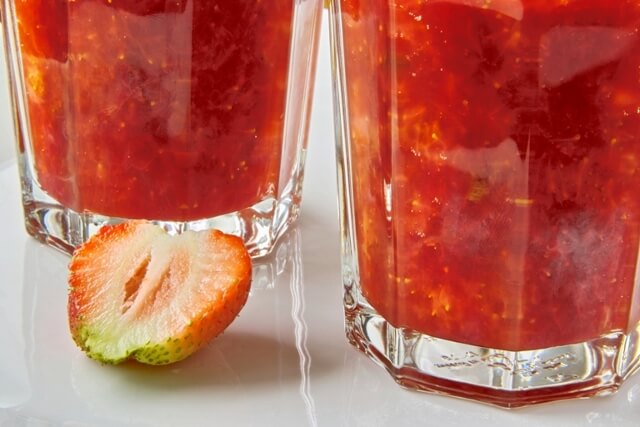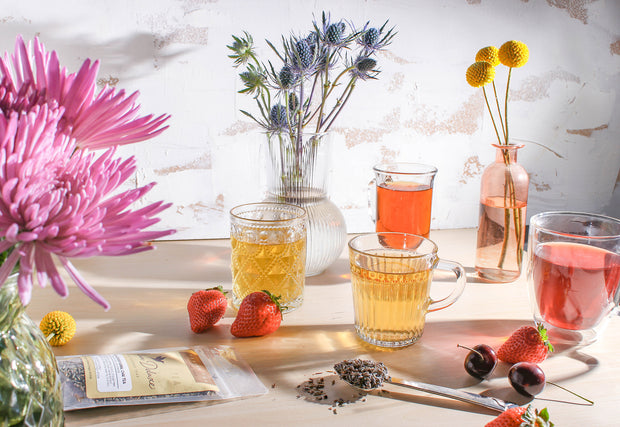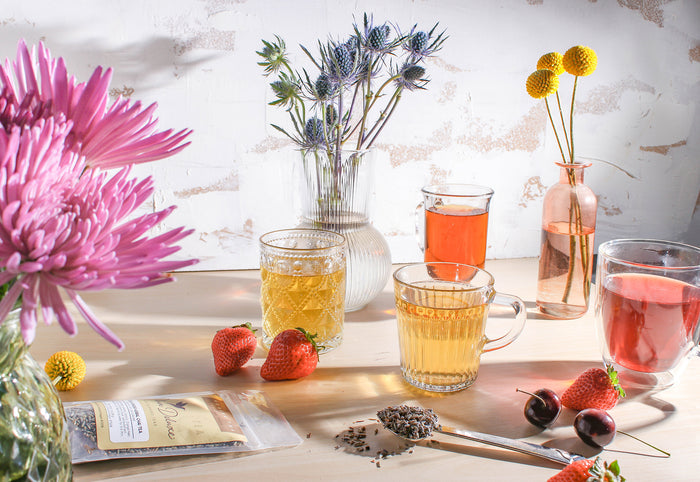
Give Your Hosts a Jar of the Best Jam Ever
Here in Oregon, berries are an embarrassment of riches: raspberries, strawberries, blueberries, and blackberries of all types. Oregon strawberries are unique, in that they are bred for flavor, sweetness, and juice -- but they don’t travel well and must be used within about a day of picking or they will mush and mold. That being said, the sweetness, juiciness, and flavor make them ideal for jam.
We also have incredible cherries, peaches, nectarines, apples, plums, pears, and figs; when they ripen, the local farmers markets are full to bursting.
Several years ago, I came across an article in Sunset Magazine about an incredibly easy technique for making low-sugar fruit jams, and it works a treat for berries of all types, stone fruits (such as peaches, apricots, nectarines, and plums), fresh figs, and even apples and pears for fruit butters. The reason the preserves are so delicious (and easy!) is that the technique involves cooking the fruit in a very slow oven.
As the fruit cooks slowly, the juices are released and much of the water is evaporated. The resulting jams are intensely fruity and sweet from the fruit sugars concentrated in the small amount of remaining juice. No pectin is needed, and you don’t have to stand and stir or risk scorched pans.
Naturally, the yield is a lot lower than with traditional jams, but the flavor is spectacular and you won’t miss all of the added sugar.

Low Sugar Fruit Jam
Makes 8 half-pint jars
Ingredients:
- 8 quarts of prepared ripe fruit (see below)
- 5 cups of granulated sugar
- 3/4 cup fresh lemon juice
Preparation:
Preheat your oven to 350 degrees.
Start with the prepared, fully ripe fruit. If you are using berries: wash and hull them and put into a non-reactive baking pan large enough to hold them while providing a large surface area. If the strawberries are large, halve or quarter them. Rectangular cake pans work well. Mash the berries lightly with a potato masher to start releasing some juice.
If you are using stone fruit or other tree fruit: wash, stem, remove pits or seeds, and cut the fruit into 1-inch chunks. If you intend to puree the finished jam, peeling is optional. (I usually use organic fruit from my own trees and I don’t peel ). Place the fruit in a non reactive pan or pans as above.
For each 8 quarts of fruit, add 5 cups of granulated sugar and 3/4 cup fresh lemon juice. Allow the fruit to sit at room temperature for about 30 minutes to release some of the juices.
Place your pan(s) with the fruit mixture in the oven for about 10 minutes to release more juice, then stir and reduce the temperature to 225 degrees.
Check your fruit every half hour or so, and give it a stir. If you need to go out, simply turn the oven off and re-start it at 225 degrees when you return. Continue checking and stirring periodically until most of the juice has evaporated and the juice passes the “saucer test.”*
For the jam you intend to use immediately, cool and store in the refrigerator in a closed container. How long will it last? Don’t know -- it never lasts long enough in my house to worry!
To store the jam for gifts: Ladle the hot jam into warm, sterilized half-pint canning jars, leaving 1/2-inch of head space. Seal and process in a boiling water bath for 10 minutes.

*Saucer test:
Place a spoonful of the jam on a chilled saucer. Run the back of a spoon through it. If the juices immediately run together, the jam is still too liquid. If the spoon trail remains in the saucer, the jam is done.
For fruit butters:
For fruit butters, substitute brown sugar for white sugar.
For apple butter, add cinnamon, nutmeg, and clove to taste when the fruit is close to fully cooked, then puree and use the saucer test to check for doneness.
For pear butter, add powdered ginger to taste when the fruit is close to fully cooked, then puree and use the saucer test to check for doneness.
Optional:
For smaller batches, cook the fruit in a slow cooker, uncovered. Start on high, and as soon as the juices start to simmer, reduce the heat to low. Stir periodically until the fruit concentrates and the jam passes the saucer test.
Greet a New Neighbor with Chocolate Bark -- ‘Cause Who Doesn’t Like Chooclate?
Super easy, super delicious, and even reasonably healthy*. With the bioflavonoids and low sugar of good quality dark chocolate, dried fruit and nuts, these chewy chunks of chocolate are a great “welcome to the neighborhood” any time of year.
*I went to a lecture by a well known physician and researcher from Oregon Health Sciences University, who told us that one ounce of 70% dark chocolate per day reduced your chances of heart attack or stroke by 50%. But it has to be dark chocolate -- milk chocolate doesn’t provide the health benefits.

Chocolate Bark with Dried Fruits and Nuts
Makes 24 pieces (but if I were you, I would make two batches since your family will NOT want you to give it all away!)
Ingredients:
- 1 pound of good quality dark chocolate 70% or greater, grated or finely chopped
- 1 cup whole roasted nuts (almonds, cashews, hazelnuts, or a combination)
- 1 1/2 cups chopped dried fruit (cherries, apricots, cranberries, ginger, or a combination)
Preparation:
Melt the chocolate in a double boiler or in a stainless steel bowl set over a pot of simmering water. Be careful to not introduce ANY water to the chocolate or it will seize into a grainy mess.
Line a 9- or 10-inch square baking pan or small sheet pan with baker’s parchment, or use a silpat silicone sheet to line the pan.
Pour the melted chocolate into the lined baking pan or spread it onto the silpat in a square about 9 or 10 inches on a side. Distribute the nuts and fruit evenly over the chocolate, and allow it to cool until it is firm. It will take at least a couple of hours.
Either break the bark into irregular pieces or use a hot knife to score it into squares and break along the score lines.
Store in a cool, dry location. Don’t refrigerate or the chocolate might bloom (i.e.develop a white coating on the surface which doesn’t harm the chocolate but is unsightly). When you are ready to present it to your new neighbor, place pieces in a decorative tin or in a tissue-lined box.
Cheer Up a Sick Friend or Co-worker with Homemade Cordial
Cordials are full of vitamins and antioxidants, can be sipped straight up to sooth a sore throat or cough, added to sparkling water or served over ice to sooth a fever, or added to a cup of hot green tea for flavor and added nutrition.

Ingredients:
- 2 1/4 pounds of berries (blackberries work very well, or you can use a mixture of berries), washed and hulled
- The juice of one fresh lemon
- 1 3/4 cups of granulated sugar (or substitute 1 1/2 cups honey)
- 2 1/4 cups water
Preparation:
Place the fruit in a non-reactive saucepan along with the water and lemon juice. Bring the contents slowly to a boil over medium-low heat. Reduce the heat to a simmer and continue simmering for about 20 minutes. Remove the pan from the heat.
Strain the fruit juices into a large bowl using a large, fine-mesh strainer or jelly bag and allow to drain overnight.
Discard the pulp and pour the juice into a clean, non-reactive saucepan.
Add the sugar or honey and cook over low heat, stirring constantly, just until the sweetener is completely dissolved.
Pour immediately into warm, sterilized jars, leaving 1/3 inch of head space, and seal. Store the jars in a cool, dark place for up to 6 months.
In today’s fast-paced world, a gift of something homemade brings back that neighborly feeling like nothing else. And, of course, you and your family reap the benefit too. Bon appetite!
All photos are by author or are free stock images.

!['Chocoholic' Chocolate Tea Variety Pack [6-Pack Variety of Flavors]](http://www.plumdeluxe.com/cdn/shop/files/2.01-1800x1800-PlumDeluxe-DAJ-274695.jpg?v=1736886689&width=165)
![Patisserie Dessert Tea Variety Pack [6-Pack Variety of Flavors]](http://www.plumdeluxe.com/cdn/shop/files/4.01_-_1800_x_1800_-_Plum_Deluxe_-_DAJ_-_274695.jpg?v=1736886720&width=165)















